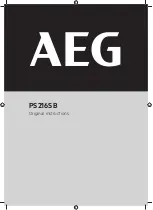
34
▶ Slide Cut
▼ WHAT’S A SLIDE CUT?
•
A “slide cut” is made with the head assembly
unlocked and able to move away from the fence.
This movement is supported and precisely
controlled by the axial glide system. The
maximum cross-cutting capacity is utilized by
using this method.
•
A slide cut is best used for cross-cutting
workpieces wider than can be done with a chop
cut – pieces wider than 2-1/2" and up to a
maximum width of 12-1/4" across.
NEVER pull the saw toward
you during a cut. The blade
can suddenly climb the workpiece causing
KICKBACK.
▼ MAKING A SLIDE CUT
1.
Properly
position
workpiece.
Make
sure
workpiece is clamped firmly against the table and
the fence.
Use clamping position that does not interfere
with operation. Before switching tool on, lower
head assembly to make sure clamp clears guard
and head assembly.
2.
Loosen the slide rail lock knob.
Use a clamping position that
does
not
interfere
with
operation. Before switching “ON”, lower head
assembly to make sure clamp clears guard and
head assembly.
Be aware of the path of the
saw blade. Make a dry run
with the saw Off by conducting a simulated
cutting cycle, and observe the projected path of
the saw blade. Keep hands at least six (6) inches
away from the projected path of the saw blade.
3.
Grasp the switch handle and pull the head
assembly away from the fence, until the blade
clears the workpiece or to its maximum extension
if blade cannot clear the workpiece (figure 38).
4.
Activate the switch. Lower the assembly all the
way down and cut through the edge of the
workpiece.
5.
Push (but do not force) the head assembly
towards the fence to the full rear position to
complete the cut.
6.
Wait until blade comes to a complete stop before
returning head assembly to the raised position
and/or removing workpiece.
FIG. 38
Saw Operations
2610051821.qxp_BM CM8S 9/19/18 2:55 PM Page 34
















































